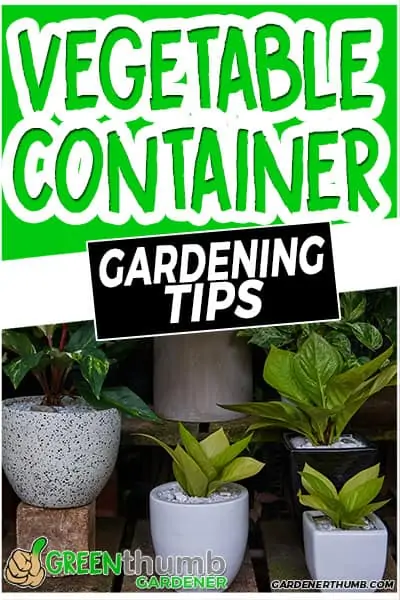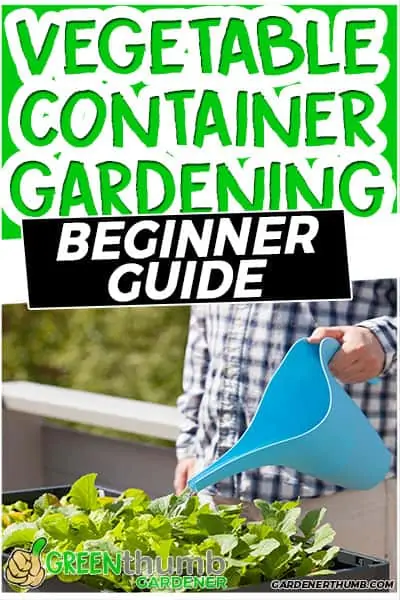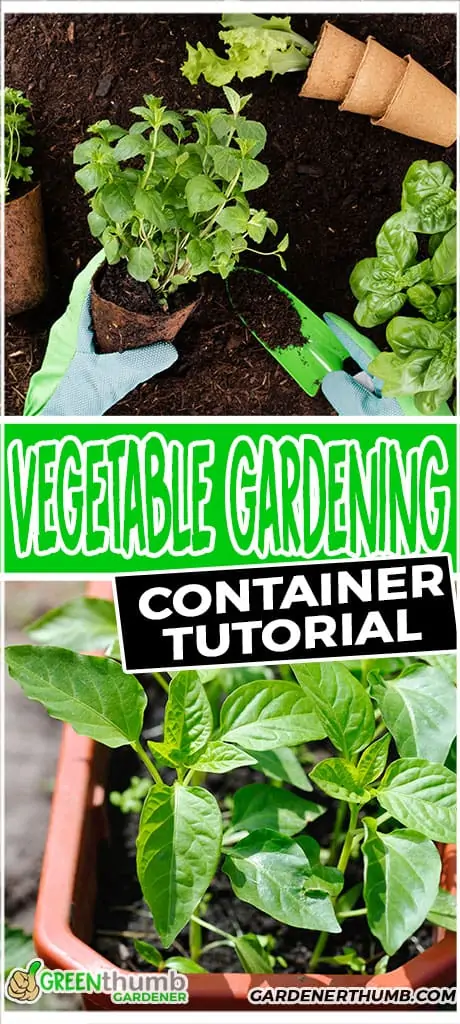Vegetable Container Gardening For Beginners
Last updated: 01/27/21
Your gardening hobby probably stemmed from a desire to save money on some of your favorite ingredients.
What started out as a small, basic herb garden, quickly grew to an actual vegetable garden in my parents’ backyard.
Moving into an apartment with less than ideal space for a garden stumped me. Luckily, I came across a guide for vegetable container gardening for beginners and my desperation for more room quickly dissipated.
If you have a small amount of space for a garden or just want to diversify your landscape, allow me to guide you.
Green thumb Gardener occasionally links to product and/or services offered by vendors to assist you with all your gardening needs. Some of these may be affiliate links, meaning we earn a small commission if items are purchased.
Want to Download a Garden Hack Guide for FREE

Enter your email below and we will send you a guide to help you SAVE money in your garden.
Listen to this post on the Green thumb Gardener Podcast
Subscribe to the Green Thumb Gardener Podcast on iTunes, Spotify, Or Google Podcast HERE
Best Type Of Container To Use
While vegetable container gardening has multiple benefits such as saving water, time, and space, you must do your research first to receive the greatest return on this investment.
Luckily, container gardening is traditionally easier and more manageable than starting a garden in the ground.
Below is a list of types of containers that can be used and the benefits and drawbacks of each. After all, over-researching a project is far superior to under-researching.
Terra Cotta Pots
These are great because many veteran gardeners already have them on hand. Plus, they look great, especially in southwestern landscapes. Unfortunately, their drawbacks are tough because the clay retains heat and can absorb the water quickly (and crack if the temperatures become cold enough).
If you thoroughly enjoy the look of terra cotta pots, be sure to line it with a plastic pot first to hold in the moisture.
Plastic Pots
These are great for new gardeners. They’re affordable, reusable, and colorful. These will retain water for your plants pretty well.
But, if you’re looking to infuse design features into your patio or backyard garden, plastic may not be the most aesthetically pleasing.

Pro tip: Get your family and friends involved if you choose to use plastic! Have a DIY container painting party before you plant to use it not only as an opportunity to beautify your garden, but also enjoy time with those most important to you.
Not only will this add color to your garden, but will also serve as a beautiful reminder of your loved ones.
Wooden Barrels or Wooden Window Planters
These are great because they are beautiful. They add diversity to your garden and provide you with an opportunity to DIY. However, keep in mind that after a while the wood will begin to rot and will need to be replaced. Great option if you’re down for re-creating by hand every few years.
Hanging Pots
These are a great option for continuing to save space and add verticality to your space. These can be kept at eye-level and are perfect for growing herbs, cherry tomatoes, and strawberries.
Bath and Other Tubs and Troughs
If you have the access to these as well as the desire, they can transform your landscape into an eccentric space. These are great because they have plenty of space and generally aren’t too deep to waste your soil.
Be sure to drill your drainage holes at the bottom and ensure that feet are attached to keep the container above ground.
Additional Tips To Consider
- Plant similar herbs and vegetables in the same pot. Try to group these plants by water and sunlight needs for easier maintenance. More information on companion planting later.
- Keep and eye on which parts of your lawn or patio get direct and indirect sunlight and place pots accordingly.
- When choosing a pot, consider the weight. You may find yourself needing to move the containers around for a variety of reasons and moving them with ease is a plus! Additionally, having a backyard (or front yard) landscape that can be easily rearranged is great to have on those days when you have a burning desire to change something about your living space.
- Stay away from black pots or black plastic; they will retain more heat and could kill your roots.
- The most common pot sizes range from 10-inches in diameter to 24-inches in diameter. While wider pots are preferred, deeper doesn’t necessarily mean better. (morningchores.com)
- While taller containers look great (and will prevent your furry friends from digging up your precious radishes) know that your roots will only need about a foot to grow downward. Don’t spend the extra money on soil to fill up that extra space at the bottom! Fill it up with hay, wood cuttings, or even your own compost to maximize the space.
- Make sure that whatever container you use, there are plenty of drain holes. If there are not, drill some yourself. Put your containers on small wooden feet or another tool to lift it from the ground; pots that are placed directly on cement can quickly become plagued with clogged drain holes and quickly end your new endeavor with root rot.
Potting Soil and Plant Food For Your Containers
Unfortunately I had to learn the hard way that soil IS important. You don’t need to break the bank for good soil, just buy your standard potting soil from your local hardware store or nursery.
If your soil doesn’t have fertilizer already mixed in, add some several times throughout the growing season, according to the directions on the label. Then, every couple of weeks, add diluted liquid fish emulsion or liquid seaweed to give the plants the nutrition they need.
If you’re feeling ambitious and want to create a putting soil from scratch, here is one of my favorites:
- 1 bucket (10 quarts) peat moss
- ½ bucket (5 quarts) perlite
- ½ bucket (5 quarts) vermiculite
- ½ bucket (5 quarts) screened compost or composted cow manure
- 2 cups fine sand
- 2 cups pelleted time-release fertilizer
- ½ cup lime (to counter the acid of peat and keep the pH level near neutral)
And don’t forget to save your food scraps when you’re cooking!
Creating your own compost is a great way to naturally and organically fertilize your plants (while also reducing your amount of weekly garbage).

Container Garden Watering Guide
As mentioned above, planting similar vegetables, fruits, and herbs together can save you immense time and brainpower. Keep your plants that need similar amounts of sunlight and water together.
To determine when and how often to water, stick to the rule that you do with other types of gardening: place your finger into the soil.
If it is dry past two inches, it’s time to water! If not, hold off.
We want to avoid both overwatering and underwatering, so trust the soil to tell you what it needs.
If you choose to start your container gardens from seed (which leads to greater fulfillment in my opinion), make sure that the soil is most, plant your seeds according to package directions, plant more than you need in the event that some don’t make it, cover with more soil, and give it one more watering.
If you choose to start your container with baby herbs, fruits, and vegetables from your local hardware store or nursery and have already begun growing, squeeze the bottom of the plant to release the root ball and encourage growth, plant in damp soil, and cover with more soil just up to the bottom of the showing stem.
Water again.
Warning: Don’t drown your plant! Your soil wants to be damp, not wet. A great way to conserve water in the soil is to place mulch on top. While this may not be an avenue that you want to go down for design purposes, it does increase the low-maintenance aspect of container gardening.
Plant Food For Your Container Garden
Your container garden, and the plants within, will need more and more food and water as they grow. Be sure to buy a quality soil that allows for proper drainage and use a nutrient solution to pour over your soil.
Know that your soil will soon become depleted as your fruits, vegetables, and herbs continue to grow and eat the fertilizer, so consistent replenishment is necessary.
If you’re leaning toward a more natural approach, try natural liquid fertilizer combinations.
Blend your soil with ingredients such as liquid bone meal, blood meal, feather meal, and rock phosphate to create a well-rounded fertilizer and growth stimulant.
Also, don’t forget about that compost!
This is a great way to keep your soil healthy and full of nutrients!
Best Container Vegetables for Beginner Gardeners
These fruits, vegetables, and herbs work BEST for beginning your container garden
Peas
Keep an eye on your peas because their beautiful flowers and the resulting fruit will pop up quickly! harvest and eat quickly for the best flavor.
Cucumbers
Cucumbers tend to thoroughly enjoy sunlight and warmth. If these conditions are consistent, your plant will grow wild with beautiful yellow flowers and will vine wherever you let it.
Save these guys for your deeper pots as their roots grow much deeper than the typical fruit/vegetable.
Tomatoes
Tomatoes are a pest favorite. If you can, place your tomatoes in a screened in area or spray with pesticides. There are few things more discouraging and seeing your tomatoes blossom one day and go rotten the next.
Summer or Zucchini Squash
Be sure to include trellises, cages, bamboo sticks, or other supports for these fruits and vegetables as they tend to climb/grow upward
Garlic
If you choose to grow garlic by planting a stray garlic clove from your kitchen, keep an eye out for the greens that grow from it.
Cut these for a very flavorful soup garnish or salad topping. be sure to keep about three inches of the greens intact for optimal growth and strength.
Bell Peppers and Chili Peppers
I recommend starting out with these plants, especially if you live in a warm state. They grow easily and thrive if you forget to water for a few days. When they first pop up from their flowers, they will be green.
If you would like for your pepper to have a more intense flavor, wait until it turns red.
Salad Greens
Leafy greens and salad greens are a great option and an even better idea for a window flower pot. Opening a kitchen window and grabbing what you need for your dinner salad seems too good to be true, but not anymore.
Carrots
Remember that these guys grow downward so you’ll want these in deeper pots. If you live in an area that has harsh winters, pull your carrots AFTER the very first heavy frost.
This makes your carrots sweeter.
Radishes
Radishes make beautiful leaves which turn into fun toys for dogs and cats. Make sure they are out of reach and don’t forget that the leaves have great nutritional value as well!
Herbs
Most herbs will work great in a container garden, especially if you’re a beginner. I’ve found that the easiest and sturdiest herbs to begin with are basil, parsley, cilantro, and lemon balm!
Mint, lavender, rosemary, and thyme are also great herbs to use to keep pests away from the other plants in your container garden.
Pro Tip: Try to stay away from vining fruits and vegetables like pumpkins and melons. These will have difficulty growing as they take up a large amount of space as they vine outward and grow larger and heavier.
Companion Planting Guidelines
When beginning a container garden, consider planting companion plants. Companion planting aids in ease of care, efficiency in space, and optimal growing environments.
Good Companion Plants Combinations
- Beans, carrots, squash
- Eggplant, beans
- Tomatoes, basil, onions
- Lettuce, herbs
- Spinach, chard, onions
Companion Plants Combinations to Avoid
- Beans with onions and garlic
- Carrots with dill or fennel
- Tomatoes or squash with potatoes
- Onions with beans and peas
Final Thoughts
Container gardening has allowed me to continue my gardening hobby while I only have a small patio to work with.
For those of you with families, enjoy this hobby as an opportunity to teach your kids about the reward of growing your own foods.
Container gardening makes growing fruits, vegetables, and herbs immensely easy and manageable since you have more control over sunlight, shade, availability to pests, and space.
Good luck and have fun!









